Related Research Articles
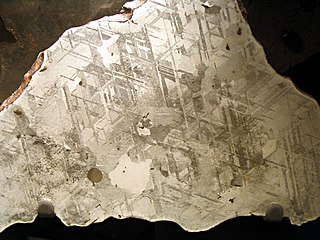
Kamacite is an alloy of iron and nickel, which is found on Earth only in meteorites. According to the International Mineralogical Association (IMA) it is considered a proper nickel-rich variety of the mineral native iron. The proportion iron:nickel is between 90%:10% and 95%:5%; small quantities of other elements, such as cobalt or carbon may also be present. The mineral has a metallic luster, is gray and has no clear cleavage although its crystal structure is isometric-hexoctahedral. Its density is about 8 g/cm3 and its hardness is 4 on the Mohs scale. It is also sometimes called balkeneisen.
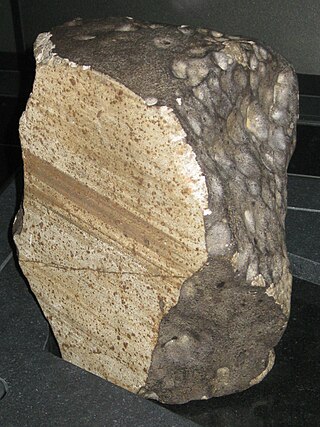
The Wold Cottage meteorite fell near Wold Cottage farm in 1795, a few miles away from the village of Wold Newton in Yorkshire, England.

Claxton is a city in Evans County, Georgia, United States. The population was 2,746 at the 2010 census, up from 2,276 in 2000. It is the county seat of Evans County.
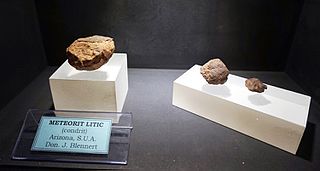
In meteoritics, a meteorite classification system attempts to group similar meteorites and allows scientists to communicate with a standardized terminology when discussing them. Meteorites are classified according to a variety of characteristics, especially mineralogical, petrological, chemical, and isotopic properties.

A chondrule is a round grain found in a chondrite. Chondrules form as molten or partially molten droplets in space before being accreted to their parent asteroids. Because chondrites represent one of the oldest solid materials within the Solar System and are believed to be the building blocks of the planetary system, it follows that an understanding of the formation of chondrules is important to understand the initial development of the planetary system.

A chondrite is a stony (non-metallic) meteorite that has not been modified, by either melting or differentiation of the parent body. They are formed when various types of dust and small grains in the early Solar System accreted to form primitive asteroids. Some such bodies that are captured in the planet's gravity well become the most common type of meteorite by arriving on a trajectory toward the planet's surface. Estimates for their contribution to the total meteorite population vary between 85.7% and 86.2%.

The iron meteorites of the IIE chemical type are octahedrites of various coarseness, most of which contain numerous inclusions of recrystallized stony silicates.

The H type ordinary chondrites are the most common type of meteorite, accounting for approximately 40% of all those catalogued, 46% of the ordinary chondrites, and 44% of all chondrites. The ordinary chondrites are thought to have originated from three parent asteroids, whose fragments make up the H chondrite, L chondrite and LL chondrite groups respectively.

The ordinary chondrites are a class of stony chondritic meteorites. They are by far the most numerous group, comprising 87% of all finds. Hence, they have been dubbed "ordinary". The ordinary chondrites are thought to have originated from three parent asteroids, with the fragments making up the H chondrite, L chondrite and LL chondrite groups respectively.

The L type ordinary chondrites are the second most common group of meteorites, accounting for approximately 35% of all those catalogued, and 40% of the ordinary chondrites. The ordinary chondrites are thought to have originated from three parent asteroids, with the fragments making up the H chondrite, L chondrite and LL chondrite groups respectively.

The LL chondrites are a group of stony meteorites, the least abundant group of the ordinary chondrites, accounting for about 10–11% of observed ordinary-chondrite falls and 8–9% of all meteorite falls. The ordinary chondrites are thought to have originated from three parent asteroids, with the fragments making up the H chondrite, L chondrite and LL chondrite groups respectively. The composition of the Chelyabinsk meteorite is that of a LL chondrite meteorite. The material makeup of Itokawa, the asteroid visited by the Hayabusa spacecraft which landed on it and brought particles back to Earth also proved to be type LL chondrite.
Qidong is a L/LL5-an chondrite meteorite fallen in 1982 in China. After detonation a single individual specimen was found in the field. Other circumstances of fall and recovery were not reported.

Albareto is a meteorite which in July 1766 fell near the frazione Albareto, of Modena, Emilia-Romagna, Italy.
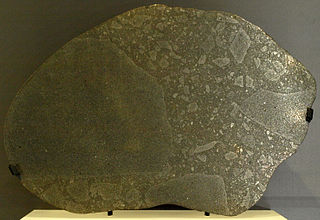
Enstatite chondrites are a rare form of meteorite, rich in the mineral enstatite. Only about 200 E-Type chondrites are currently known, comprising about 2% of the chondrites that fall on Earth. There are two main subtypes: EH and EL, classified based on their iron content.
Andura is an H chondrite meteorite that fell to Earth on August 9, 1939, in Maharashtra, India.
Archie is an H chondrite meteorite that fell to earth on August 10, 1932, in Archie, Missouri.
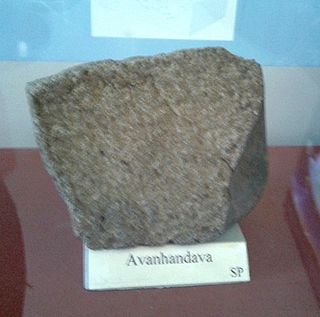
Avanhandava is an H chondrite meteorite that fell to earth in 1952 in São Paulo, Brazil.
Benton is a meteorite found near the village of Benton, New Brunswick following a fireball. Two masses were found but the meteorites were split up. The largest fragment is now in the Canadian National Meteorite Collection, Ottawa.
This is a glossary of terms used in meteoritics, the science of meteorites.

The Ordovician meteor event was a dramatic increase in the rate at which L chondrite meteorites fell to Earth during the Middle Ordovician period, about 467.5±0.28 million years ago. This is indicated by abundant fossil L chondrite meteorites in a quarry in Sweden and enhanced concentrations of ordinary chondritic chromite grains in sedimentary rocks from this time. This temporary increase in the impact rate was most likely caused by the destruction of the L chondrite parent body 468 ± 0.3 million years ago having scattered fragments into Earth-crossing orbits, a chronology which is also supported by shock ages in numerous L chondrite meteorites that fall to Earth today. It has been speculated that this influx contributed to, or possibly even instigated, the Great Ordovician Biodiversification Event, although this has been questioned.
References
- 1 2 Meteoritical Bulletin Database: Claxton
- ↑ "Claxton Meteorite". New England Meteoritical Services. October 2000. Retrieved 10 June 2013.
- ↑ Meteoritics, Vol. 20, 1985
- 1 2 "Bonhams : Historic Meteorites and Related Americana".